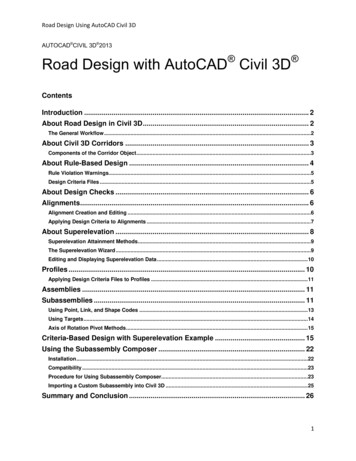
Transcription
Road Design Using AutoCAD Civil 3DAUTOCAD CIVIL 3D 2013Road Design with AutoCAD Civil 3D ContentsIntroduction . 2About Road Design in Civil 3D . 2The General Workflow . 2About Civil 3D Corridors . 3Components of the Corridor Object . 3About Rule-Based Design . 4Rule Violation Warnings. 5Design Criteria Files . 5About Design Checks . 6Alignments . 6Alignment Creation and Editing . 6Applying Design Criteria to Alignments . 7About Superelevation . 8Superelevation Attainment Methods . 9The Superelevation Wizard . 9Editing and Displaying Superelevation Data . 10Profiles . 10Applying Design Criteria Files to Profiles . 11Assemblies . 11Subassemblies . 11Using Point, Link, and Shape Codes . 13Using Targets . 14Axis of Rotation Pivot Methods . 15Criteria-Based Design with Superelevation Example . 15Using the Subassembly Composer . 22Installation . 22Compatibility . 23Procedure for Using Subassembly Composer. 23Importing a Custom Subassembly into Civil 3D . 25Summary and Conclusion . 261
Road Design Using AutoCAD Civil 3DIntroduction AutoCAD Civil 3D engineering software provides civilengineering professionals with targeted solutions for a widevariety of infrastructure projects, including land development,transportation, and water projects.This document is an overview of workflows using AutoCAD Civil3D for basic road design. These workflows are straightforward inthe creation of dynamic models and built based on applicableindustry-recognized or user-defined standards.Figure 1: A Civil 3D road corridor model.The overview begins with fundamentals and the general workflow for building road models. Then the behaviors andfunctionality of the overall road model and its individual components are described. Finally, an example is shown.About Road Design in Civil 3DThe General Workflow Create base map—Road design typically begins by creating an existing conditions surface and compiling abase map of existing conditions; information about the topography, parcels, utilities, and other potentialimpacts to the route design. Design alignment—An alignment defines the main horizontal route that typically represents the constructionbaseline of the roadway. Alignments may be created using field-collected survey information or from existingCAD entities such as lines, arcs, or polylines. Optionally, they may be created using the wide variety ofalignment layout tools. Apply design criteria—Determine the design intent and the constraints that are to be placed on thealignment. This includes speed and superelevation parameters. Design criteria may be assigned at theonset of the alignment layout or at any time during the design process. Warning alerts will aid in the swiftdesign of a conforming alignment. Generate existing ground profile and design grades—Display existing ground surface data for the designalignment and create the finished grades. Finished grade profiles may be created graphically using profilecreation tools, or generated from a best fit analysis of existing entities or from information from an externalfile. Construct assemblies—Assemblies define the cross-sectional component of the design and are built byconnecting individual subassembly objects, thereby helping to simulate the geometry and material makeupof the road as well as helping to define how it interacts with surrounding features along the route. Thesubassemblies are selected from the prebuilt libraries contained in the Civil 3D Tool Palette. Customsubassemblies can also be created using the Subassembly Composer. Build the corridor—Corridors are the resulting dynamic 3D model representation built from the combinationof horizontal, vertical and cross-sectional design elements. Analyze resulting model—Corridors may be used to calculate earthworks and quantity takeoffs, to performsight and visual analysis, to generate surfaces, and to extract information for construction purposes.2
Road Design Using AutoCAD Civil 3DIndividual corridor sections may be examined and edited to help accommodate unique or localized designconditions. Optimize design—To achieve a better design it may be necessary to adjust one or more of the corridorcomponents. For example, you can adjust the design profile to better balance cut and fill volumes. Edits maybe done using a variety of methods, such as grips, via tabular inputs, and with object-specific editingcommands. In addition, since the road design is dynamic, changes made to one component affect the entireroadway model.About Civil 3D CorridorsCorridors combine surface, alignment, profile, and assembly information to create dynamic three-dimensionalrepresentations of route-type features, such as roads, railroads, channels, and bridges.Corridors are the main design object of road modeling and simulation in Civil 3D. They rely on interaction with othermodel objects and they help to simulate behavior prescribed by assignable and customizable parameters, such asdaylighting, lane widening, and superelevation schemes.A corridor is created by applying an assembly along the horizontal and vertical path defined by the combinedinformation of the alignment and profile. To complete the corridor, targets are specified to achieve daylighting.The type of corridor, such as a trench, a channel, a path, a road, or a bridge, is determined by the assemblyconfiguration that is applied along the baseline at desired intervals. The assemblies that are used to create thecorridor may contain sophisticated behavior such as conditional targeting, widening, and superelevation.The result is a 3D model that extrudes the specified assemblies along the desired path. Feature lines connect similarpoints from assembly to assembly. These feature lines establish the longitudinal edges of the 3D model. Individualpoints in the assembly may also be assigned behavior that automatically follows prescribed targets, such as curbreturn alignments or lane-widening feature lines.The resulting corridor model may be used to generate cross-section sheets, earthwork and material volumes, featurelines, and surfaces. Surfaces derived from the corridor can represent finished grades, subgrades, or any number ofunderlying component surfaces. These surfaces may be used for visualization, material quantity, and constructionpurposes.Components of the Corridor ObjectThe corridor object is built using baselines, assemblies, regions, parameters, and optional surfaces. Figure 2 shows aportion of a corridor and the components used to create it.Figure 2: A baseline is defined bythe alignment and profile thatcontrol the horizontal and verticalaspects of the road. An assemblyis then inserted to follow this path.3
Road Design Using AutoCAD Civil 3DThe corridor components are: Baseline—A baseline defines the horizontal and vertical route. It is derived from combining the alignmentand the design profile. Assembly—An assembly represents the cross-sectional design of the road. Assemblies are collections ofinterlocking subassemblies, which may contain dynamic design parameters such as conditional daylightingor lane widening. Regions—Individual portions of corridors enable application of different design parameters. Transitions fromone region to the adjoining region automatically occur. Regions are defined by starting and ending stationranges. Corridor parameters—Corridor parameters are required to build a corridor object. These are assigned inthe Corridor Properties panorama. The parameters are: region starting and ending stations, assembly name,frequency of assembly attachments along the region station range, and identifying any necessary targets tosatisfy subassembly behavior. Corridor targets—By using the subassemblies parameters, the corridor has the ability to target surfaces,alignments, profiles, feature lines, polylines, and survey figures. Through this interaction, corridors can bedesigned to automatically tie embankments to a surface, widen a lane along an alignment, match a ditchinvert to a profile, and accommodate many other design scenarios. A corridor may be modeled without asurface; however, daylighting is required to perform certain road model analysis, such as earthworkcalculations. Generally speaking, targets are used when the geometry of the corridor needs to change asthe design progresses along the baseline.About Rule-Based DesignUsing AutoCAD Civil 3D, you can compare the design of roadelements against recognized industry standards or userdefined standards. As designers work to lay out designs, thesoftware provides graphic alerts and/or notification tips to helpalert you when standards are not met.This capability helps provide many benefits, including greatertime savings, reduced rework due to fewer review comments,more consistency, and, above all, sound engineering design.This is made possible using design criteria and design checksets.Design criteria may be assigned to the horizontal geometry ofthe centerline, for example, helping to meet the minimumradius criteria for horizontal alignments based on designspeed.Design criteria can also be assigned to profiles. The criteriaconsiders minimum K values based on required stopping,passing, and headlight sight distance derived from designspeed.Figure 3: Design criteria and design check sets are options ofAlignment and Profile Properties.4
Road Design Using AutoCAD Civil 3DDesign checks are another way to control road design as the geometry is being laid out. For example, design checkscan be established that limit the minimum length of alignment tangents.Rule Violation WarningsWarnings appear in several locations to help give the designer notification when a violation to the applied criteria ordesign checks occurs. Alert symbols are displayed at locations along the alignment or profile where the violationsoccur. Hovering over the symbol displays the tool tip, which gives a brief summary of the violation. The display of thewarning symbol is controlled by the alignment style.Warning symbols will also display in the entity grid view to help notify the designer of any issues. The designer canchoose to correct the issues or ignore them if the design requirements permit. When the issues are resolved, thewarning symbols will disappear.A design criteria report can be generated, helping to identify whether each subentity within a given station rangeviolates or meets the appropriate design criteria and design checks. The reporting utility is accessed in the Toolboxtab of the Toolspace.Figure 4: Violations of designcriteria and design checksappear in several places towarn users.Design Criteria FilesAASHTO-based design criteria files are included withAutoCAD Civil 3D software. These files can be usedas-is, or copied and modified to better suit specificdesign needs. The application of design criteria is anoptional property of the alignment and profile objects,as shown in Figure 3. The Design Criteria Editor is usedto create custom criteria files, as shown in Figure 5.The default folder location for design criteria files is: \ProgramData\Autodesk\C3D 2013\enu\Data\CorridorDesign Standards\Figure 5: Editing design criteria in the Design Criteria Editor.5
Road Design Using AutoCAD Civil 3DAbout Design ChecksDesign checks are another way to help track and control the road design in real time and can be used by themselvesor in conjunction with design criteria files. Design checks use mathematical expressions to compare a geometricproperty of an alignment or profile with a predetermined value.For example, roadway design may require that tangent road segments be longer than a specified length, or that curveradii exceed a minimal radius.Design checks are managed through the Settings tab of the Toolspace and can be arranged into design check sets.Figure 6: Design check rules are easy to modify and create. They are accessed in theAlignment or Profile collection of the Settings tab in the Toolspace.AlignmentsAlignments define the horizontal routes for features such as channel ways, utility trenches, roads, and bridges. Theirgeometry is represented by straight line tangents and a variety of curve and spiral types.When individualgeometry is connectedto create analignment, rule-baseddesign constraintsmay be applied.Alignment Creationand EditingAlignments may becreated in a variety ofways. They may becreated from existingline, arc, and polylineentities, or they maybe created using theAlignment Layouttools, as shown inFigure 7: The Alignment Creation menu and the Alignment Layout toolbar.6
Road Design Using AutoCAD Civil 3DFigure 7. Alignments are edited using grip edits or alignment editing commands. Editing may also be done in tablesusing the alignment grid view, as shown in Figure 8.Figure 8: Alignments maybe edited using graphicalmethods or by changingvalues in the Alignmententity panorama.Applying Design Criteria to AlignmentsDesign criteria can be applied at the onset of the alignment creation, or added later by using the Design Criteria tab ofthe Alignment Properties panel. When criteria and design checks are assigned at the onset, the designer can havethe advantage of real-time warnings when violations occur.Additional design speeds can be added as required in the Design Criteria tab of the Alignment Properties panel, asshown in Figure 9.The use of a Design Check Set is also toggled on in the Design Criteria tab of the Alignment Properties panel.Tangency between alignment entities can also be checked via Design Criteria settings.Figure 9: Adding design speeds to the alignment criteria.7
Road Design Using AutoCAD Civil 3DFor real-time warnings during the layout of thealignment, the Use criteria-based design andUse design check set options are selected atthe onset of alignment creation, as shown inFigure 10.About SuperelevationSuperelevation is the banking of a curve to helpcounterbalance the centrifugal forces that avehicle experiences while traveling through acurve.When superelevation parameters are applied tothe alignment object, the resulting corridormodel will rotate and warp the cross-sectionallinks and shapes to reflect the raising of oneedge of the travel way above the other.The corridor relies on the behavior ofsubassemblies to adjust their final shape andposition accordingly. Many out of-the-box Civil3D subassemblies support superelevation.Figure 10: Applyingdesign criteria and designchecks at the onset of thealignment creation.Figure 11: An example of superelevationbeing applied to a divided highway model.8
Road Design Using AutoCAD Civil 3DSuperelevation Attainment MethodsAutoCAD Civil 3D supports two methods of superelevation attainment: Standard: used on undivided, crowned roadways and divided roadways with crowned or planar sections. Planar: used on undivided, planar-section roadways, such as ramps and service roads.The attainment method uses a series of formulas to calculate the length of the transition regions that transform theroad from normal crown to full superelevation. Using formulas to establish relationships between maximumsuperelevation rates, runoff and runout lengths, and other variables, each specific transition region can be calculated.These values are obtained from the assigned design criteria file.The Superelevation WizardThe Superelevation wizard helps you define superelevation using a four-step process with visual cues at each step inthe process. As options are selected, the associated configuration image will react to display the method scheme, asshown in Figure 12.Figure 12: The first task in theSuperelevation wizard is to select theroadway type. The images change toreflect a schematic representing themethods and options selected.The wizard specifies roadway type, number of lanes, shoulder control, and attainment method for calculatingsuperelevation.The Superelevation wizard is used to: Calculate the superelevation for all curves or a selected curve in an alignment Store the design criteria in the superelevation curve manager for review or editing after data is calculatedThe designer should have a well-defined concept of the design and desired superelevation behavior before startingthe wizard. However, if design intent changes it is easy to reapply the Superelevation wizard to existing data, andthere is a warning prompt to verify that all existing values will be overwritten.9
Road Design Using AutoCAD Civil 3DEditing and Displaying Superelevation DataSuperelevation values for individual curves are displayedand edited using the Superelevation Curve Manager. It isaccessed by selecting the alignment either in the drawing orfrom the Prospector tab.A grid view of all superelevation values for the entirealignment may also be used for review and editing. The gridview is launched by selecting the View Tabular Editor in thealignment context commands, as shown in Figure 14.Figure 13: Launching the Superelevation wizard.Figure 14: Both a grid view and theCurve Manager may be used to reviewand edit superelevation values.ProfilesProfiles define the surface elevation along an alignment. Design grade profiles are defined using tangents andvertical crest and sag curves.Profile geometry may be controlled using design criteria that specify three types of minimum K tables based onstopping sight distance, passing sight distance, and headlight sight distance (K-value represents the horizontaldistance along which a one percent change in grade occurs on the vertical curve).Additional criteria and design checks can include slopes and curves that are designed for safe or comfortable drivingat a particular speed, or for sag curve drainage considerations.10
Road Design Using AutoCAD Civil 3DApplying Design Criteria Files to ProfilesDesign criteria is applied to profiles using methods similar to the ones used for alignments; criteria and design checkscan be applied at the onset of design or afterwards.If the profile’s parent alignment uses design criteria, that design criteria file is automatically applied to the profile bydefault.AssembliesAssemblies represent the cross-sectional composition of the road design. Assemblies are collections of individualsubassembly components representing items such as medians, lanes, curbs, sidewalks, and shoulders. An exampleis shown in Figure 15.The assembly object serves as the baseline to which the designer snaps together any number of premadesubassembly pieces from the Civil 3D Tool Palette.Figure 15: An assembly is made of upa combination of subassemblies suchas sidewalks, curbs, and lanes.Assemblies may contain functionality that is critical in the building of complex road systems, such as intersections,conditional daylighting, and superelevation. An example of an assembly with conditional daylighting is shown inFigure 16. The steepness of the cut condition is automatically adjusted when a rock type surface is encountered.Figure 16: This assemblyexample has conditionaldaylighting functionality. Theslope of the cut condition isautomatically adjusted toaccommodate differentsurface types.SubassembliesAutoCAD Civil 3D contains an extensive collection of subassemblies for a wide variety of road design applications.The scope of their application ranges from simple marked points and generic links to very sophisticated superelevated lane objects with axis of rotation options. Custom subassemblies can also be made from AutoCADentities or by using the Subassembly Composer.The basic components of subassemblies are points, links, and shapes. Their geometry and behavior are controlledby input parameters.11
Road Design Using AutoCAD Civil 3DParameters vary depending on the intended function of the subassembly. Some parameters are static, manuallyentered values, while others are derived automatically from another object or entity within the drawing. For example,a lane width may be assigned to follow a meandering polyline instead of holding a fixed value. This is an example ofa target parameter. Surfaces are also common parameters, as they are needed to calculate the daylighting.Subassemblies can also be tied to the superelevation parameters of the alignment. As the corridor is built, anysubassemblies that reference superelevation will recognize the information contained in the alignment and respond toit. For example, subassembly lane objects will automatically adjust their cross-slopes throughout transition and fullsuperelevation regions along the alignment curves.Figure 17: Subassemblies are madeup of points, links, and shapes. Stylescan be assigned to each component,providing users with greater controlover display and labelingcharacteristics of the subassembly.Styles are used to control the appearance and labeling of the individual point, link, and shape components of thesubassemblies. The many styles required are grouped into Code Sets. Code Set settings are located in the Generalcollection on the Settings tab of the Toolspace, as shown in Figure 18.Figure 18: Code Set stylescontrol the appearance andlabeling of subassemblycomponents.12
Road Design Using AutoCAD Civil 3DUsing Point, Link, and Shape CodesPoints, links, and shapes are the basic building blocks of subassemblies, and they each have assigned codes. Codesare used for many purposes. For example, point codes can control the creation of corridor feature lines, such as adaylight line, as shown in Figure 19.Figure 19: Using point codes tocreate corridor feature lines.When the corridor is built, the matching point codes from the subassemblies are connected from assembly toassembly, creating corridor feature lines. These feature lines inherit the same name of the point code from which theyare derived.This robust corridor model information is used to create surfaces representing finished grades, subgrades, andmaterials. The surface shown in Figure 26 was created from feature lines representing the finished grade.Figure 20: A surface created fromfeature lines extracted from acorridor. The feature lines used inthis example represent the finishedgrade.Effective use of point, link, and shape code styles can greatly improve the efficiency of documenting and displayingroadway designs throughout the entire project.Additionally, link codes can be assigned a render material for visualization purposes and an area fill material forhatching purposes within the drawing.Codes can also be used to automate the labeling of section views, as shown in Figure 21.13
Road Design Using AutoCAD Civil 3DFigure 21: Using point and link codes to automate section view labeling.Using TargetsMany AutoCAD Civil 3D subassemblies have the ability to interact with other objects in the drawing through targetparameters. For instance, all daylighting subassemblies require the use of a surface target parameter. The job of thedaylight subassembly is to seek out and intersect with a given surface according to the instructions provided by theinput parameters.Many different daylighting scenarios can be modeled using the daylight subassemblies provided with AutoCAD Civil3D software. For example, some daylight subassemblies will seek out a surface and tie to it while maintaining a givenwidth for the daylight embankment. Others can automatically create benches, ditches, and berms, and/or adjust theslope, depending on the material being excavated.Other subassemblies, such as lanes, medians, and sidewalks, have the ability to target feature lines, alignments, andsurvey figures to control width and change shape as they progress along the corridor. A turning lane, for example,can be modeled using a transition subassembly along with a feature line target representing the edge of the travelway. As the feature line moves away from the road centerline, the subassembly widens to create the additional lane.Slope or elevation targets can also be utilized with some assemblies to control the vertical aspect of the road design.For instance, a profile could be applied to the edge of the travel way to control its elevation and at the same time thealignment is controlling its horizontal position.Some subassemblies can even target a marked point, enabling them to seek out a specific location on anothersubassembly and connect to it, such as seeking out a marked point on an access ramp assembly and automaticallycreating a swale between the two roadways.14
Road Design Using AutoCAD Civil 3DAxis of Rotation Pivot MethodsPivot point locations are not always at the insertion point of an assembly. When the pivot point location needs to bespecified at the inside edge of a curve, the outside edge of a curve, or always on the left or right edge of a roadway,special subassemblies must be used that contain pivot functionality, and the ability to support axis of rotation (AOR)at prescribed pivot point locations. Subassemblies that are used between the pivot point and the baseline raise orlower the profile grade line to accommodate the pivot point. All of the subassemblies comprising the pivotingassembly must have the ability to support the axis of rotation calculation.Subassemblies that support AOR display the possible pivot point locations when they are added to the assemblyconstruction. The symbol appears as a half diamond shape flag with a line to the pivot spot on the subassembly, asshown in Figure 12. The desired pivot location is set in the subassembly parameters.Figure 12: An assembly displaying possiblepivot point locations.Criteria-Based Design with Superelevation ExampleDeveloping a four-lane divided road with alignment and profile design criteria and superelevation is demonstrated inthe following overview. This example does not include the use of a special Axis of Rotation.The design begins with the creation of the baseline alignment.On the Home tab:Alignment Alignment Creation ToolsIn the Create Alignment dialog, name and set the general options for the alignment, then select the Design Criteriatab. On the Design Criteria tab set the design speed and toggle onthe Use criteria-based design option. Now you can apply designcriteria and or design checks, as shown in Figure 22.In this example, the design speed is 60 miles per hour and thecriteria is defined based on a standardized file using standardAASHTO formulas. The Basic design check set is also selected.Criteria-based design is now invoked and violation alert symbols canbe displayed when alignment entities are not in compliance.Alignment geometry is edited graphically using grips and glyphs,which represent different geometry points, or in the grid view wherevalues may be accessed directly, as shown in Figure 23.Figure 22: Apply criteria before the alignment isdrawn.15
Road Design Using AutoCAD Civil 3DFigure 23: Violations also app
Road Design Using AutoCAD Civil 3D 2 Introduction AutoCAD Civil 3D engineering software provides civil engineering professionals with targeted solutions for a wide variety of infrastructure projects, including land development, transportation, and water projects. This document is an overview of workflows using AutoCAD Civil
![AutoCAD Free [Updated] 2022 - Só EPI não basta](/img/61/autocad-16.jpg)

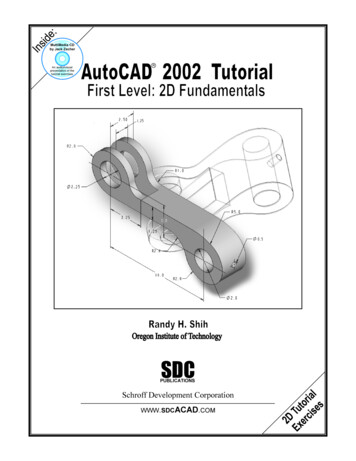


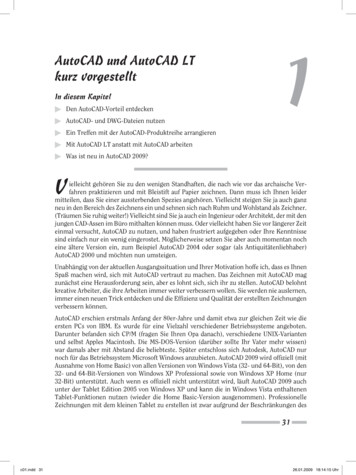


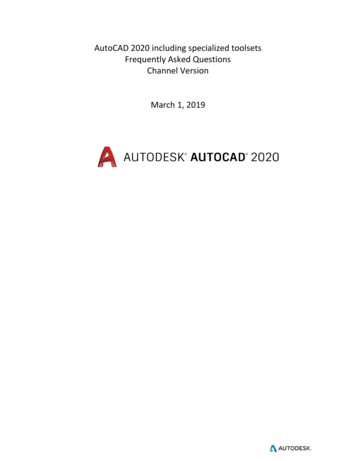

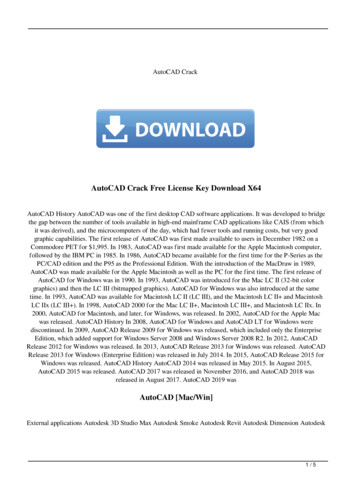
![AutoCAD Keygen For (LifeTime) Free [Win/Mac]](/img/66/yaletan.jpg)